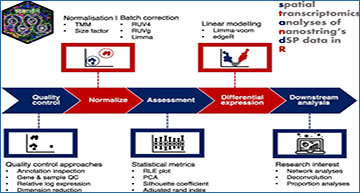To gain a better understanding of the complexity of gene expression in normal and diseased tissues it is important to account for the spatial context and identity of cells in situ. State-of-the-art spatial profiling technologies, such as the Nanostring GeoMx Digital Spatial Profiler (DSP), now allow quantitative spatially resolved measurement of the transcriptome in tissues. However, the bioinformatics pipelines currently used to analyse GeoMx data often fail to successfully account for the technical variability within the data and the complexity of experimental designs, thus limiting the accuracy and reliability of the subsequent analysis. Carefully designed quality control workflows, that include in-depth experiment-specific investigations into technical variation and appropriate adjustment for such variation can address this issue.
Researchers at the Walter and Eliza Hall Institute of Medical Research have developed standR, an R/Bioconductor package that enables an end-to-end analysis of GeoMx DSP data. With four case studies from previously published experiments, they demonstrate how the standR workflow can enhance the statistical power of GeoMx DSP data analysis and how the application of standR enables scientists to develop in-depth insights into the biology of interest.
Availability – https://davislaboratory.github.io/GeoMXAnalysisWorkflow/
Liu N, Bhuva DD, Mohamed A, Bokelund M, Kulasinghe A, Tan CW, Davis MJ. (2023) standR: spatial transcriptomic analysis for GeoMx DSP data. Nucleic Acids Res [Epub ahead of print]. [article]





